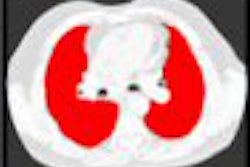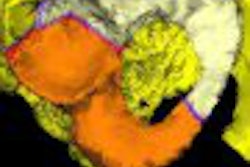BARCELONA - You're special. Your family is special. Even your illness, heaven forbid, is a little different from what ails the guy down the street -- though you may share a diagnosis.
Modern medicine, long a champion of one-size-fits-all care, has a ways to go before it starts treating you like the unique individual you are. But some very smart people and organizations, a lot of them in fact, are working to make it so.
The heart and soul of this new medical paradigm is none other than the rapidly evolving imaging workstation, said Dr. Heinz Lemke, professor of computer graphics and computer-assisted medicine at the Technical University of Berlin, and a founder of the Computer Assisted Radiology and Surgery (CARS) conference.
"The main message is that we need to think of patient-specific models in the future and model-guided therapy if we want to introduce personalized medicine, and workstations will play a major role in this," he said at the CARS 2008 meeting.
On Wednesday, Lemke and Dr. Michael Vannier, professor of radiology at the University of Chicago, talked about the new disease model, the role of advanced imaging and therapeutic workstations in it, and the army of researchers working to make it so.
"We're in the midst of a major revolution in medicine, where the older, empirical type of medicine is being replaced by the deliberate, customized version which attends to the differences among individuals, which is the so-called personalized medicine," Vannier said.
Traditional trial-and-error medicine is the paradigm of the past, he said. The focus of the present and the future is to use technologies, organizations, and training "in order to change the way we do business in medicine."
The sea change affects not just doctors but medical organizations as well, he said. While the hospital was the center and principal care provider in the old model, the new paradigm represents a "value-added" model where doctors coordinate their tools and knowledge to add value to patient care in a proposition that is greater than the sum of its parts.
It will require special technology infrastructure, including the processing-heavy thick-client technologies like PACS workstations, but far more from emerging thin-client workstations or portals that operate more like Web sites, delivering images to mobile phones, for example, without the constraints of thick-client systems.
The portability and ease of use associated with thin-client architecture has carved itself a place in patient care and will grow exponentially, Vannier said. Thin-client workstations process the greatest workload while using the slimmest infrastructure, he said.
However, thick-client solutions are still needed for advanced processing-intensive and real-time indications, none more than the 320-slice CT scanner, he said, which "places extraordinary burdens on PACS systems" such that a standard PACS simply cannot handle the image data.
Among the types of workstations that are evolving most rapidly are the highly specialized surgical or interventional workstations; radiotherapy workstations are another example of how imaging can be delivered for a variety of specific care models.
"Treatment planning systems, delivery systems, treatment verification systems -- all are integrated in the radiotherapy practice in order to deliver the benefits of radiotherapy," Vannier said. While imaging modalities deliver many essential services, the unique functions of workstations, such as image segmentation, are central to the patient-specific model that uses "multiple imaging modalities, multiple encounters, and treatment episodes" that rely on specialized systems for the planning and delivery of care for any disease care process.
Workstations in the OR
Operating room workstations have become an area of intense activity in workstation development, Vannier said. Look at any photograph of an operating room and you'll see a wide variety of image-delivery systems; it's their integration that has not always been developed and is the key task of research today, led by DICOM, which standardizes image delivery and organization between systems, Integrating the Healthcare Enterprise (IHE), and other organizations such as the National Electrical Manufacturers Association that endeavor to meld systems to facilitate workflow.
In fact, the number of modalities with embedded systems in an operating room is quite large, and integrating the functions to facilitate workflow is seen as one of the principal research challenges today, Vannier said.
In DICOM, for example, the task of interoperability among imaging systems is being undertaken by far-ranging workgroups that are taking specific topics such as cardiovascular imaging and thoracic imaging toward the goal of integrating workflow, the sequence of steps required to complete a task.
"In the hospital, there are systems for registering patients, systems for collecting images and distributing them, systems for billing, systems for postprocessing, systems for administering and monitoring anesthesia," he said. "In the operating room, there's basically a surgical workflow that needs to make use of all these disparate systems, and to do so without standards has not been as practical as anticipated."
An example of how a workstation adds benefit can be found in a simple orthopedic surgery case, where the patient has fractured a tibia. The workstation software outlines the fracture and then displaces the bone fragment to preplan how the bone should be returned to its original, prefracture position in surgery.
"When you've done this a number of times you realize that you're collecting information that is potentially reusable," Vannier said. In this way, workstations will become the centers of data repositories that speed care based on a history of similar cases. The repository-based workflow basically looks like a flowchart of how the procedure will be performed in integration with multiple OR systems.
Integrated surgical systems
A few such highly integrated surgical systems are already operational, such as the MRI-guided HIFU (high-intensity focused ultrasound) transducer that includes high-field MR, a positioning device (robot) and associated drivers, temperature measurement, cavitation detection, an MR-compatible camera, and software.
HIFU's positioning device has three user-controlled degrees of freedom that allow access to various targeted lesions, according to lead investigator Christakis Damianou, Ph.D., and colleagues (International Journal of Computer Assisted Radiology and Surgery, April 2008, Vol. 2:6, pp. 335-345).
With HIFU, the patient lies inside the MR scanner and the workstation guides the ultrasound ablation therapy, which can potentially be used for uterine fibroid embolization and a number of other therapies, Vannier explained.
Another highly integrated system, the da Vinci surgical system (Intuitive Surgical, Sunnyvale, CA), has become adept at performing prostatectomies and other procedures. In da Vinci as in HIFU, the operator sits at a viewing station and operates through the robot arms, Vannier said. Minimally invasive spinal surgery is another area undergoing rapid development.
The development of these advanced systems is an imperative, he said, in an era when the same number of radiologists has to contend with workload increases of 20% and more each year.
"It has created this kind of perfect storm where there are an increasing number of examinations, the exams themselves are increasingly complex, and require more postprocessing," he said. "We have the same number of radiologists, the same number of hours in a day. What are you going to do with all these additional exams?"
The radiologist shortage of 2000-2002 in the U.S. was solved by and large by increasing productivity -- delivered by PACS and by workstations. The integration of systems currently under way will advance those goals further, he said. But productivity gains will be more complicated for the next generation.
"One of the challenges we face in the clinical enterprise today is that there are so many sources of images," he said. "Images come from radiology, from pathology, from cardiology, and so on, and it's just not practical to have a separate PACS for each department in an enterprise."
Standards will be key to making it all work together, just as they have for plumbing and tires and CDs and DVDs and electrical appliances, Vannier said.
DICOM, despite being only partially developed, has been extremely valuable as a "plug-and-play" facilitator, while IHE and other standards, which might be compared to the actual wiring diagram, are equally indispensable.
Avoiding obsolescence
When developing new workstations, it pays to think about what has happened to all the old ones, which have become piles of "useless, rusting junk," Vannier said. Developing equipment and interoperability and functionality standards, he said, are key to forestalling obsolescence and keeping equipment in service for longer periods of time.
"Virtualization" is one of several helpful trends aiming in this direction by concentrating the maximum number of services into the minimum number of machines, thereby minimizing costs, "all of this at a time when there's a move toward personalizing healthcare, episodic treatment, electronic health records, and artificial expert systems," Vannier said.
The use of grid technology to manage a "cloud" of Internet resources, a concept developed jointly by Google and IBM, envisions a public network of servers in an emerging computer paradigm where data and services can be delivered flexibly and at a reduced cost on a massive scale.
"It has tremendous advantages [for healthcare]; it's virtual, scalable, efficient, flexible -- all the things we find wrong with traditional legacy systems," Vannier said.
Workstations used in healthcare and medical imaging, and efforts to integrate them with information technology, are in a rapid state of evolution today, Lemke said, and a universe of research centers and collaborations are already in place to advance the ideas of interoperability, integration, and efficient delivery of services. The massive challenges will be solved by the people who choose to advance the goals of integrated healthcare.
"You don't want to land your workstation too quickly in the junkyard," Lemke said.
By Eric Barnes
AuntMinnie.com staff writer
June 26, 2008
Related Reading
3D development outpaces facilities' readiness, June 23, 2008
IT users need to demand more from vendors, May 15, 2008
Advanced visualization's benefits come with integration challenges, April 7, 2008
IHE launches new domain, March 27, 2007
CARS suite of the future sees key role for image-guided intervention, June 2, 2005
Copyright © 2008 AuntMinnie.com



















